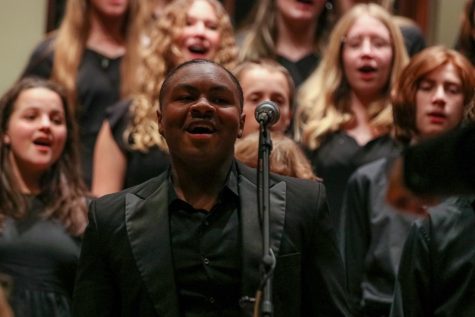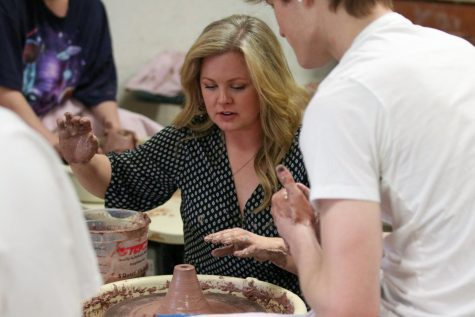He’s still trending
Shakespeare remains relevant 400 years after his death
Photo: Mrs. Rubin de la Borbolla
Seniors Alexis Margaritis and Kyle Mehmed pose for a photo following their “Hamlet” performance. Students have engaged with Shakespeare in the classroom by reenacting plays and watching modern adaptations.
I’ve been a fan of Shakespeare since I was in middle school. I had a small role in my first Shakespeare play at the ripe young age of 13, and I’ve enjoyed reading his works both on my own time and in school ever since. Though it was difficult to grasp at first, his language captivated me, and I’ve grown to truly appreciate Shakespeare’s way with words.
Shakespeare’s wit is timeless and adaptable, providing room for modernization and expansion. He has remained relevant for 400 years, and signs show that he isn’t planning on burning out anytime soon. Though I personally adore Shakespeare, he’s not always so popular among the masses.
“One of the biggest problems I have with students is getting them to engage with the language,” middle school English teacher Mr. Pat McGraw said. “It’s not his plotting that makes Shakespeare great, but it’s really his language that, to me, sets him apart.”
This is where modern adaptations come into play. When used as a tool to draw the attention of 20th century brains, modernized Shakespeare is made accessible and enjoyable.
St. George’s students begin their relationship with Shakespeare in the 7th grade, reading and studying “A Midsummer Night’s Dream.” His works continue to be taught up until senior year, where students are required to deepen their analytical skills by transcribing monologues, learning scenes and performing portions of scripts.
Mr. Jamie Roszel and Ms. Jennifer Vasil’s English II classes recently finished watching two different adaptations of the 1623 Shakespearean drama “Macbeth” as a means of deepening their understanding of the text. There are over 15 different movie versions of this production, and it continues to be remade over and over again, even today. Ms. Vasil’s classes watched the 2010 version, starring Sir Patrick Stewart and directed by Rupert Goold, while Mr. Roszel took a even newer approach with the 2015 version, starring Michael Fassbender and directed by Justin Kurzel.
Shakespearean literature continues to be performed in front of live audiences as well, both on a grand scale and in the St. George’s classroom. St. George’s English classes in grades 10 and 12 recently put on scenes from “Othello,” “Macbeth” and “Hamlet.” Complete with costumes and their own setting, these performances were used as another angle from which to view Shakespeare and better understand him.
Needless to say, you don’t have to perform Shakespeare to enjoy his works. There are many opportunities in the community and the entertainment industry as a whole for students to engage with Shakespeare. Our very own Tennessee Shakespeare Company puts on a full season of a show every year, and individual theaters in the local area take on this endeavor as well, including Theatre Memphis and Playhouse on the Square. As for feature-length films, “A Midsummer Night’s Dream” is currently streaming on Netflix, and “Othello” can be found on Hulu. These are perfect options for those that would prefer an actual performance of a Shakespearean play as opposed to a cold reading of a script, which is what Shakespeare himself intended.
All of these versions give young people to opportunity to encounter Shakespeare in a variety of ways.
“You can remake over and over again, but people are always going to want to go back to the basics,” sophomore Margo Valadie, an English student and thespian, said. “I feel like really good writers will always be remembered and preserved.”









